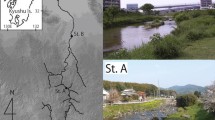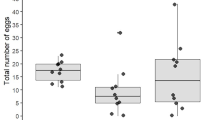Abstract
A mediterranean-type climate exists in five widely separated regions; the Mediterranean basin, parts of western North America, parts of western and southern Australia, southwestern South Africa and parts of central Chile. Streams in these regions feature seasonal disturbances of contrasting hydrology with high predictability of the timing of flooding and drying but low constancy. We would expect fish living in these streams to avoid scouring flow and breed after cessation of the flood period. The aim of the present study was to examine the adaptation of the Yarqon bleak, Acanthobrama telavivensis, an endemic cyprinid in the coastal streams of Israel, to mediterranean-type stream (mediterranean—written with a small m, is used in connection with climate or ecological region and is distinguished from Mediterranean that is used in a geographical context, referring to the Mediterranean basin.) conditions. For that we studied its reproductive strategy (age at maturity and life span, gonad activity, oocyte maturation, spawning activity and habitats, appearance of juveniles), in a major costal stream (Yarqon). Our findings show that the Yarqon bleak exhibits life history traits attuned with a mediterranean-climate hydrologic regime. It breeds in late winter and early spring, a window of opportunity between flash floods and habitat desiccation. Being a multiple spawner allows the fish to compensate for the potential loss of part of its reproductive output due to scouring flows of late floods. The ability of the Yarqon bleak to spawn on different substrate-types enables it to take advantage of different stream conditions that pertain in different years. The fish attains pre-adult size (ca. 33–42 mm) within the first year, prior to drying out of most stream reaches, and matures by the beginning of the second year (males >41; females >42 mm). The cost of these tactics is a short life span (4–5 age groups). The reproductive strategy of the Yarqon bleak falls into the category of in-channel breeding but, unlike the case suggested by a low flow recruitment model, the fish breed during the period of flood cessation, a transitional time between high and low flows, rather than at the time of low flow. Breeding at this time of the year in mediterranean-type streams puts early stages somewhat at risk of being washed away by late floods, but gains them a longer period of growth under favorable conditions. We suggest an additional positive tradeoff that should be investigated: the reduced competition with age 0 of other fish that breed later in the season. This suggested model of recruitment during the period of flood cessation seems appropriate for fish in streams with seasonal contrasting flows of high predictability but low constancy.
Similar content being viewed by others
References
Allan JD (1995) Stream ecology: structure and function of running waters. Chapman & Hall, London, pp 388
APHA (1995) Standard methods for examination of water and wastewater, 19th edn. American Public Health Association, Washington, DC
Avitzur S (1958) The Yarqon: the river and its tributaries. Hakibbutz Hameuchad, Tel-Aviv, p 231 (in Hebrew)
Bagenal TB, Tesch FW (1978) Age and growth. In: Bagenal TB (ed) Methods for assessment of fish production in fresh water, 3rd edn. Blackwell Scientific Publications, Oxford, pp 101–136
Ben-Zvi A, Gvaskenecht L, Azmon B (1995) The hydrology of the Yarqon. In: Pargament D (ed) The Yarqon. The Yarqon Stream Authority, Ramat-Gan, pp 38–44 (in Hebrew)
Ben-Zvi A, Atzmon B (1997) Flood period in selected streams in Israel. Hydrological report 3/97, Hydrological Service, Jerusalem (in Hebrew)
Cambray JA, Bruton MN (1984) The reproductive strategy of a barb, Barbus anoplus (Pisces: Cyprinidae), colonizing a man-made lake in South Africa. J Zool 204:143–168
Cattaneo F, Carrel G, Lamouroux N, Breil P (2001) Relationship between hydrology and cyprinid reproductive success in the lower Rhône at Montelimar, France. Arch Hydrobiol 151:427–450
Colwell RK (1974) Predictability, constancy, and contingency of periodic phenomena. Ecology 55:1148–1153
Cowx IG (1990) The reproductive tactics of roach, Rutilus rutilus (L.) and dace, Leuciscus leuciscus (L.) populations in the Rivers Exe and Culm, England. Polskie Arch Hydrobiol l37:193–208
Davidoff EB (1986) Verification of the scale method for ageing the cyprinid, Mirogrex terraesanctae terraesanctae (Steinitz, 1952) in Lake Kinneret (Israel). Bamidge 38:108–125
Elron E, Goren M, Gasith A (2004) Ammonia toxicity to juvenile Acanthobrama telavivensis (Cyprinidae), a critically endangered endemic fish in the coastal plain of Israel. Isr J Zool 50:321–331
Fernández-Delgado C, Herrera M (1995) Age structure, growth and reproduction of Rutilus lemmingii in an intermittent stream of the Guadalquivir river basin, southern Spain. Hydrobiologia 299:207–213
Fisher SG, Grimm NB (1988) Disturbance as a determinant of structure in a Sonoran desert stream ecosystem. Verh Int Ver Limnol 23:1183–1189
Gafny S, Gasith A, Goren M (1992) Effect of water level fluctuation on shore spawning of Mirogrex terraesanctae (Steinitz), (Cyprinidae) in Lake Kinneret, Israel. J Fish Biol 41:863–871
Gafny S, Goren M, Gasith A (2000) Habitat condition and fish assemblage structure in a coastal mediterranean stream (Yarqon, Israel) receiving domestic effluent. Hydrobiologia 422/423:319–330
Gasith A, Bing M, Raz Y, Goren M (1998) Fish community parameters as indicators of habitat conditions: the case of the Yarqon a lowland polluted stream in a semi arid region (Israel). Verh Int Ver Limnol 26:1023–1026
Gasith A, Resh VH (1999) Streams in Mediterranean climate regions: abiotic influence and biotic responses to predictable seasonal events. Ann Rev Ecol Syst 30:51–81
Goldreich Y (1998) The climate of Israel: observations research and applications. Bar Ilan University Publishers and Magnes Publications, Ramat Gan, p 292 (in Hebrew)
Goren M, Fishelson L, Trewavas E (1973) The cyprinid fishes of Acanthobrama Heckel and related genera. Bull Br Natl Hist Mus (Zoology) 24:291–315
Goren M (1974) The freshwater fishes of Israel. Isr J Zool 23:67–118
Goren M (1983) Freshwater fishes of Israel: biology and taxonomy. Hakibbutz Hameuchad, Tel-Aviv, p 102 (in Hebrew)
Goren M, Ortal R (1999) Biogeography, diversity and conservation of the inland water fish communities in Israel. Biol Conserv 89:1–9
Goren M (2004) Threatened fishes of Israel. In: Dolev A, Perevolotsky A (eds) Red data book for the vertebrates of Israel. Nature and Parks Authority and Society for Preservation of Nature, Tel-Aviv, pp 155–158
Harris JH, Gehrke PC (1994) Modeling the relationship between streamflow and population recruitment to manage freshwater fisheries. Aust Fish 6:28–30
Herrera M, Fernández-Delgado C (1994) The age, growth and reproduction of Chondrostoma polylepis willkommi in a seasonal stream in the Guadalquivir river basin (southern Spain). J Fish Biol 44:11–22
Humphries P, King AJ, Koehn JD (1999) Fish, flows and floodplains: links between freshwater fish and their environment in the Murray-Darling Rive system, Australia. Environ Biol Fish 56:129–151
Jearld A (1983) Age determination. In: Nielsen LA, Johnson DL (eds) Fishery techniques. Southern Printing Co., Blacksburg, pp 301–324
Junk WJ, Bayley PB, Sparks RE (1989) The flood pulse concept in river-floodplain systems. In: Dodge DP (ed) Proceedings of the international large river symposium. Canadian Special Publication of Fisheries and Aquatic Sciences, Ottawa, pp 110–127
King AJ, Humphries P, Lake PS (2003) Fish recruitment on floodplains: the roles of patterns of flooding and life history characteristics. Can J Fish Aquat Sci 60:773–786
LeHouórou HN (1990) Global change: vegetation, ecosystems, and land use in the southern Mediterranean Basin by the mid twentieth century. Isr J Bot 39:481–508
Levy N (2004) The relative degree of proximity between species of the genera Acanthobrama and Mirogrex (Family: Cyprinidae) in the inland freshwater in Israel. MSc. Thesis. Tel-Aviv University, Tel-Aviv, p 91 (in Hebrew with English summary)
Lulla K (1987) Mediterranean climate. In: Oliver JE, Fairbridge RW (eds) Encyclopedia of climatology. Van Nostrand Reinhold, New York, pp 569–571
Lytle DA (2001) Disturbance regimes and life-history evolution. Am Nat 157:525–536
Magalhães MF, Schlosser IJ, Collares-Pereira MJ (2003) The role of life history in the relationship between population dynamics and environmental variability in two Mediterranean stream fishes. J Fish Biol 63:300–317
Marchetti MP, Moyle PB (2000) Spatial and temporal ecology of native and introduced larval fish in Lower Putah Creek (Yolo Co. CA). Environ Biol Fish 58:73–87
Mills CA (1991) Reproduction and life history. In: Winfield IJ, Nelson S (eds) Cyprinid fishes: systematics, biology and exploitation. Chapman, Hall, London, pp 483–508
Moyle PB, Smith JJ, Daniels RA, Taylor TL, Price DG, Baltz DM (1982) Distribution and ecology of stream fishes of the Sacramento-San Joaquin drainages system, California. Univ Calif Publ Zool 115:1–256
Oliva-Paterna FJ, Vila-Gispert A, Torralva M (2003) Condition of Barbus sclateri from semi-arid aquatic systems: effects of habitat quality disturbances. J Fish Biol 63:699–709
Ostrovsky I, Walline P (1999) Growth and production of a dominant pelagic fish, Acanthobrama terraesanctae, in subtropical Lake Kinneret, (Israel). J Fish Biol 54:18–32
Pires AM, Cowx IG, Coelho MM (2000) Life history strategy of Leuciscus pyrenaicus in intermittent streams of the Guadiana basin. Cybium 24:287–297
Poff NL, Allan JD, Bain MB, Karr JR, Prestegaard KL, Richter BD, Sparks RE, Stromberg JC (1997) The natural flow regime: a paradigm for river conservation and restoration. BioScience 47:769–784
Resh VH, Brown AV, Covich AP, Gurtz ME, Li HW (1988) The role of disturbance in stream ecology. J␣North Am Benthol Soc 7:433–455
Ribeiro F, Cowx IG, Collares-Pereira MJ (2000) Life history traits of the endangered Iberian cyprinid Anaecypris hispanica and their implications for conservation. Arch Hydrobiol 149:569–586
Rinchard J, Kestemont P (1996) Comparative study of reproductive biology in single and multiple spawner cyprinid fish. 1. Morphological and histological features. J Fish Biol 49:993–894
Roff DA (1981) Reproductive uncertainty and the evolution of interoparity: why don’t flatfish put all their eggs in one basket? Can J Fish Aquat Sci 38:968–977
Snyder DE (1983) Fish eggs and larvae. In: Nielsen LA, Johnson DL (eds) Fishery techniques. Southern Printing Company, Blacksburg, pp 165–198
Soriguer MC, Bravo R, Vallespín C, Gómez-Cama C, Hernando JA (2000) Reproductive strategies of two species of cyprinids in a stream with Mediterranean regimen (SW Spain). Arch Hydrobiol 148:119–134
StatSoft, Inc. (1995) STATISTICA for windows. Statsoft Inc, Tulsa, Oklahoma
Steinitz H (1954) The distribution and evolution of the freshwater fishes of Palestine. Publ. Publications of the Hydrobiological Research Institute University of Istanbul B1:225–275
Svislotski P (1960) Spawning cycles of Acanthobrama terraesanctae from Lake Tiberias. Fisherman’s Bull Haifa 3:14–16 (In Hebrew with English summary)
ÜnlÜ E, Balci K (1994) Some biological characteristics of the Acanthobrama marmid Heckel, 1843 in the Tigris River (Turkey). Turk J Zool 18:131–139
Weddle GK, Burr BM (1991) Fecundity and dynamics of multiple spawning in darters: an in-stream study of Etheostoma rafinesquei. Copeia 1991:419–433
Winemiller KO, Rose KA (1992) Patterns of life-history diversification in North American fishes: implications for population regulation. Can J Fish Aquat Sci 49:2196–2218
Wootton RJ (1998) Ecology of teleost fishes, 2nd edn. Kluwer Academic Publishers, Dordrecht, p 448
Acknowledgments
This research was supported by the Ministry of the Environment and the Yarqon River Authority. We are grateful to Jonathan Raz and Philip Rubinzaft of the Yarqon River Authority for their field assistance. We thank Erhan ÜnlÜ (University of Diyarbakir) for unpublished information on Acanthobrama marmid and to Benny Atzmon and Margarita Chudinov of the Hydrological Service of Israel for hydrologic data. We also thank Naomi Paz for editorial remarks.
Author information
Authors and Affiliations
Corresponding author
Rights and permissions
About this article
Cite this article
Elron, E., Gasith, A. & Goren, M. Reproductive strategy of a small endemic cyprinid, the Yarqon bleak (Acanthobrama telavivensis), in a mediterranean-type stream. Environ Biol Fish 77, 141–155 (2006). https://doi.org/10.1007/s10641-006-9066-8
Received:
Accepted:
Published:
Issue Date:
DOI: https://doi.org/10.1007/s10641-006-9066-8




